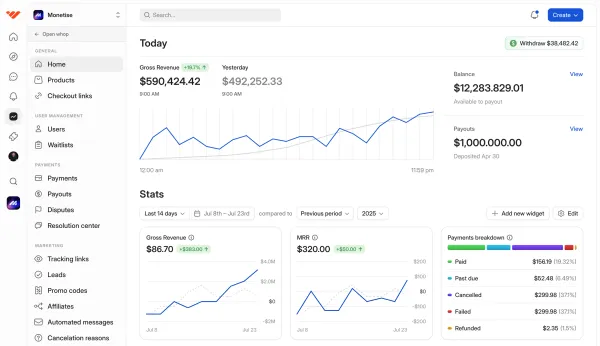Zero-based budgets are a way for businesses to track exactly where their money is going, and why. Discover why this budgeting model is becoming increasingly popular.
Key takeaways
- Zero-based budgeting requires justifying every expense from scratch, ignoring previous year's figures.
- ZBB forces managers to evaluate all expenses and explore alternatives for better resource allocation.
- Companies can create zero-based budgets multiple times yearly for increased flexibility.
- Less than 27% of organizations sustain cost reductions beyond four years traditionally.
- Zero-based budgeting promotes strategic alignment by categorizing and prioritizing expenses systematically.
Budgets are powerful tools that help bring order and organization to the chaotic world of personal and business finances. They help you become more intentional with your limited financial resources, as they’re deployed in pursuit of a limitless set of goals, objectives, and desires.
The system of budgeting is essentially focused on giving every dollar and cent a specific job to perform, so you know exactly where your money is going and why. This holds true for individuals, households, small and large businesses alike.
For businesses, however, budgeting comes in different shapes and forms, and it isn’t always about balancing the books at the end of each period, but rather strategically directing your scarce resources to activities where they’re expected to have the most impact.
One such approach to budgeting is ‘Zero-Based Budgeting’, which has gained much traction in corporate financial management in recent years. For organizations looking to cut the fluff, rein-in spending, or simply gain better control over their operations, this is a new secret weapon.
What is Zero-Based Budgeting?
Traditionally, budgeting in most organizations involves sitting with the prior year’s figures in hand and merely tweaking them by a few percentage points based on the goals, objectives, and fresh circumstances concerning the new year.
With Zero-based budgeting (ZBB), however, the slate is wiped clean, and the budget for the new cycle is prepared from scratch, without basing anything on the prior year’s figures. ZBB essentially requires users to justify every expense from zero, irrespective of what things looked like the previous year.
For many organizations and finance professionals, this was something reserved only for worst-case scenarios, and never considered during the normal course of business. As such, it is a rather extreme approach to budgeting, but one that is increasingly gaining acceptance.
Such an approach results in every dollar being accounted for, evaluated, and validated based on current needs, rather than relying on last year’s expenses as a baseline. As a result, you arrive at a leaner, more accurate, and more intentional allocation of organizational resources.
When done right, zero-based budgeting can be an absolute game-changer for businesses, helping eliminate waste and prioritize investments, while ensuring that each and every dollar is spent in pursuit of growth and value creation.
Zero-based budgeting vs regular budgeting - what’s the difference?
The Zero-Based Budget and the traditional or regular budgeting convention are quite distinct in their approaches to corporate financial planning. They each work under a different worldview, with differing levels of scrutiny and strategies to deal with problems. Here’s a brief low-down to make things clear.
| Zero-Based Budgeting | Traditional Budgeting | |
|---|---|---|
| Approaches | This budget is built from scratch, examining all the expenses an organization or particular department is set to incur, before scrutinizing each of them. | Here, the budgeting is based on the prior year's figures, with only increases and decreases being paid much attention to, rather than the whole. |
| Effort | Very effort intensive, as it involves preparation from scratch, with each expense item being scrutinized and justified. | Significantly low overall effort, as it largely focuses on modifying existing budgets, which act as a baseline for the new period. |
| Time Frame | Despite being a fairly comprehensive approach to budgeting, ZBB can be undertaken multiple times in a year, based on changing internal and external circumstances. | Usually done once a year, with the same budget remaining in force, until the end of the financial year. |
| Emphasis | With a ZBB, the emphasis is on evaluating and justifying every expense, no matter how small, big, or insignificant, to arrive at a more comprehensive financial plan. | Traditionally, the approach to budgeting involved evaluating and justifying changes to already-existing budgets carried forward from the previous year. |
| Data | Being a standalone budget that isn't based on the prior year, the data used for creating this often comes from well-qualified assumptions, market research reports, and current events. | Decisions here are largely based on historical data, with only slight adjustments made based on current goals and objectives, alongside any changes in market conditions. |
Why Use A Zero-Based Budget?
In essence, the zero-based budget is more than just a method or framework, it is a mindset that challenges you to rethink how you allocate resources. It brings a host of benefits for businesses, some of which we’ve discussed below.
You start each year with a fresh slate
The beauty of ZBB is that you start with a fresh outlook each year, as opposed to sticking with the status quo or carrying forward baggage from the prior years.
This approach is almost akin to planning your business and its operations from scratch every year, something very unconventional, and even cumbersome, but can also be beneficial in the long run, when done right.
Such an approach often leads to newer insights, identification of certain cash pits, and more. Most importantly, it gives middle management a stake in the game, making them more accountable, and aware of the workings of their particular unit.
All expenses matter
In large businesses, it is common for managers and executives to take things for granted, and not pay much attention to the minor details. By instituting a ZBB, you can change this culture, and make rigor and precision the new name of the game.
Managers are forced to re-evaluate all expenses for each new time period, justify their requirements, explore alternatives, and figure out ways to align their budget to broader organizational objectives.
For instance, if you’re an office manager planning the budget, you will have to justify reasons for a particular brand of stationary and why a cheaper alternative would not be feasible. This might seem insignificant in the larger scheme of things but can make a sizable difference when done across an organization.
You gain better visibility over your finances
In large organizations, the lack of visibility is a key source of risk, as well as a barrier to effective planning and growth. With ZBB, middle managers and senior executives stand to gain a more granular understanding of cost, their drivers, and the role their role in operations.
This helps in better planning and decision-making, while also allowing for greater controls and oversight across the various teams and departments within an organization.
The lack of visibility is a major challenge for big companies, something that only continues to compound as they grow.
Management theorists have for years tried to deal with this problem, but have only managed incremental solutions so far. A zero-based budget, however, stands to make this problem just a little bit better for the most part.
Blatant multi-million dollar frauds such as the one involving fake invoices and big tech companies such as Meta and Alphabet in recent years is a prime example of this problem.
ZBB leads to superior unit economics
The level of scrutiny that ZBB demands for each individual unit of expense ultimately leads to vastly superior margins and unit economics. For instance, when dealing with suppliers, you are now forced to go the extra mile to seek out a better deal or look for alternatives to drive value for your organization.
With this budget, sticking with certain systems and processes merely because that’s how you’ve always been doing things is no longer going to cut it. If there is a better and cheaper alternative out there, you are obliged to check it out and make a case either for or against it.
When it comes to planned cost reductions, less than 27% of leading organizations manage to sustain it for more than 4 years in the current inflationary environment. With ZBB, however, it might well be possible to deliver lasting returns.
Zero-based budgeting promotes strategic resource allocation
With clear and compelling explanations accompanying each line of the budget, it's easy for managers, department heads, and senior executives to categorize, rank, and prioritize expenses, keeping in mind the broader goals and objectives of the organization.
With Zero-based budgeting, you can prioritize expenses that drive growth, innovation, and customer satisfaction while cutting back on those that you deem a low priority.
This includes everything from investing in new technologies to expanding your marketing efforts, and boosting employee morale.
With the right use of ZBB, your budget stays aligned with your strategic objectives, across the short, medium, and long time frames to drive the highest possible return on investment.
Your business benefits from improved flexibility and adaptability
Unlike traditional budgets, ZBB’s aren’t weighed down by any kind of historical baggage, providing corporations with plenty of room to maneuver and adapt to changing market conditions, competitive pressures, and macroeconomic uncertainties.
This is largely because you’ll be reassessing your budget from zero each cycle, making it easy when responding to short-term trends, and capitalize on opportunities as they arise.
In most companies, ZBB’s are created more than once a year, as opposed to traditional budgeting practices, which makes them great for quickly reallocating resources and making operational changes to suit new developments.
You may also be interested in...
- How to start a digital marketing agency on a budget
- Rocket Money review: Is this app your launchpad to smarter savings
How to Make a Zero-Based Budget
Creating a zero-based budget from scratch might seem intimidating, but the process itself is pretty straightforward, and there are plenty of templates and frameworks to help you out with this both for businesses and personal use cases.
Here’s our breakdown to get you started on a zero-based budget, and while we are catering to businesses, the same can be applied to your personal finances as well, with just a few minor tweaks.
1. Identify goals and objectives
The first step for any kind of budgeting is clarifying your organization’s goals and objectives, for the short, long, and medium-terms. It is important to be as precise as possible with this, as it largely defines where and how everything else is likely to fall in place.
Based on the organization-wide goals, you can then come up with something similar for each individual business unit, group, or department.
For instance, if cutting costs is the rallying point for the coming year, all departments will be informed of how much expenses they are expected to cut, based on which they can then formulate their own budgets.
2. Establish rules & guidelines
Once you have the objectives in place, it is time to outline the rules, procedures, and guidelines that all departmental heads and managers will have to follow while crafting their budgets. This is essentially the framework that will define how everything is to fall into place.
For instance, are there certain things that you are unwilling to compromise on in your quest for cost cuts? Such as customer experience or employee morale, etc.
3. Engage cost drivers
Being a bottom-up approach to budgeting, a ZBB requires the involvement of all stakeholders, which includes teams, departments, and units of all sizes, which we consider to be cost drivers for the purpose of this task.
Companies are also required to assign budget owners for each of the cost centers, ideally the manager of each center.
4. Categorize & prioritize expenses
These budget owners play a crucial role in implementing the organization’s vision, vis-à-vis budget, financial planning, and objectives by scrutinizing every line of expense, justifying them, and deciding on the final budget for the team or department in question.
Before we get to the justifying and scrutinizing part, however, we first have to categorize each expense, so that it's easy to prioritize them.
This is fairly straightforward. Expenses that are required for the functioning of your business are the top-most priority, followed by those that are crucial for attaining strategic goals and objectives.
5. Start building from zero
Now comes the actual sweat and toil of diving into every activity, evaluating them from zero, and justifying their necessity in delivering the desired outcome. This includes everything, labor, raw materials, technology, marketing, and more.
While scrutinizing the costs, it is also essential to evaluate alternatives. For instance, is there any other supplier willing to offer you lower prices on raw materials?
6. Review & monitor
Once the budget is ready for deployment, it is best to conduct a peer review to ensure everyone is on the same page and nothing gets missed out, before sending it for approval by the senior leadership.
There may be some to and fro here before any changes and differences get ironed out before the ZBB enters the implementation stage.
Once implemented, however, the job doesn’t end there, since ZBBs are all about continuous improvement. Meaning budget owners will have to continually monitor performance, track variances, make the necessary adjustments, and report the results.
This is by far one of the most crucial aspects of zero-based budgeting, as it's almost impossible to get it right on the very first attempt. The goal is to continually track and refine the process, before arriving at a system that delivers optimum results for your organization year after year.
A Zero-Based Budget Example
Let’s bring this to life with a practical example. Here we have come up with a zero-based budget for the marketing department of a fictional tech company, that we have named PixelForge.
Goals & Objectives
The B2B SAAS company wants to generate consistent leads for its services from across the globe and with the use of multiple marketing options, but it is focused on minimizing its cost per lead.
Total Budget - $4,000,000
Digital ad campaigns
Justification - Significantly better-targeting capabilities compared to other options, making this the cheapest source of leads for the company, with quick cash cycles and ROIs.
Cost Breakdown:
- Contextual Ads (Google, Bing & MediaNet) - $800,000
- Social Media Ads (Facebook, LinkedIn & TikTok) - $500,000
- Video Ads (YouTube) - $200,000
Total - $1,500,000
Influencer marketing & shoutouts
Justification - Fewer conversions and higher cost per lead, but builds long-term brand authority.
Cost Breakdown:
- Influencer Campaigns (Instagram, Twitter & Snapchat) - $500,000
- Shoutouts (YouTube & Facebook) - $500,000
Total - $1,000,000
Content marketing
Justification - Significantly slower leads and cash cycles, but can result in massive organic search traffic over time, which can bring in substantial low-cost leads.
Cost Breakdown:
- Blog Posts & Articles - $150,000
- Video Content Production - $200,000
- eBooks, Reports & Whitepapers - $150,000
Total - $500,000
Trade shows & event sponsorships
Justification - Helps showcase the brand among a targeted group of potential buyers in highly engaged zones such as trade shows and industry events.
Cost Breakdown:
- Industry Conferences - $500,000
- Webinars - $300,000
- Trade Show Booth - $200,000
Total - $1,000,000
Budget allocation summary
- Digital Ad Campaigns - $1,500,000
- Influencer Marketing & Shoutouts - $1,000,000
- Content Marketing - $500,000
- Trade Shows & Event Sponsorships - $1,000,000
Total Budget - $4,000,000
Post budget monitoring & performance review
Based on regular quarterly reviews, it has since come to light that trade shows and event sponsorships are failing to generate sufficient leads to justify the costs. Similarly, due to recent Google updates, content marketing efforts aren’t yielding satisfactory results.
As a result, it makes sense to eliminate Trade Shows & Event Sponsorships altogether, reduce allocations to content marketing, and redeploy both in favor of digital ad campaigns to maximize lead generation and marketing ROIs.
Explore Whop for More Personal Finance Advice

Zero-based budgeting has been on a fiery streak in the corporate world over the past couple of years, and for good reason. It effectively helps converge strategic management with corporate finances, helping organizations gain a much wider visibility of their operations than compared to traditional systems.
While zero-based budgeting requires effort and discipline, the benefits far outweigh the challenges. Whether you’re a small business owner looking to tighten the reins or a larger organization seeking to optimize resources, zero-based budgeting offers a clear path to smarter financial management.
If you’re looking for deeper insights on budgeting, personal finance, or the zero-based budgeting itself, consider exploring the wide variety of communities, courses, and products on Whop.
Join 1,000s of creators and millions of like-minded members who struggle with the same challenges as you, and are currently looking for options to scale their personal or business finances.
Why are zero-based budgets trending?
Zero-based budgets are not a new concept and have been around since the late 60s. However, given the sheer amount of resources that were required to make them work effectively, they were mostly restricted to academic study and not for large-scale practical applications.
After all, imagine working with stacks of paper that are moved from one department to another, and finally, all sent back to the CFO for further review and approval of the final budget. Any mistake or a lost sheet in between could have wreaked havoc on the organization’s finances.
However, with growing digitalization, building a zero-based budget is well within the reach of most organizations. Now add to this the forces of AI and machine learning and every single challenge or drawback that this system posed in the past is taken care of.
From sifting through vast amounts of data to coming up with insights based on prevailing market conditions and the organization’s own history and spending habits, AI can do it all. This means, that we now have the technology to not only implement ZBB but to implement it with greater efficiency and accuracy.



